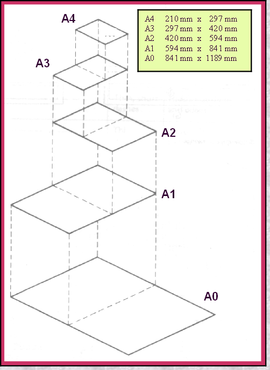

Use our online designer studio to create your own personalised flyers, business cards, greeting cards and more.
Order NowWhen it comes to professional printing and advice on your business marketing, we are the team to call! You can call us direct on 04 568 8773 or fill in our quote form.
Request a Quote
Why is A4 smaller than A3 paper? Why is there a still a Foolscap refill pad size for school? Why does the printing company squash my flyer or not print it at all when it looked fine on the computer screen? When I need to send a greeting card, what is the right size envelope to pick? These and many other questions about paper sizes will be answered in this informative article.
The A size was introduced by the Germans in 1922 and you can read up about Paper Sizes in the Wikipedia to find out it’s history. In a nutshell it was found by using a very simple mathematical equation you can have a rectangle that when you divide the long edge in half or multiply the short edge by two this will always give your the same proportional size but halving or doubling the total area of paper. Because it’s always more economical for a printer to print multiple copies of a page on a larger sheet of paper than to print it on a smaller sheet more times, the number scale used for it is keeps halving the page size as the number increases. A0 is roughly one square meter of paper, while A1 is half that or ½m 2 , A2 is 1 2 2 or ¼m 2 so on to A4 (which everyone uses) is 1 2 2 2 2 or 1 over 2 4 or 1m / 16m 2 of paper. This sizing keep getting smaller till we reach A8 which is 52mm × 74mm (smaller than a business card) in size or 1/256 of a square meter of paper. With improvements in printing and paper manufacturing technology the A sizes go larger too, 2A0 and 4A0. 4A0 is 4m 2 of paper or a sheet roughly 1.7 × 2.4 metres in size. Another reason why this standard was quickly adopted around the world was because the thickness and cost of paper is measured by weight, it made it very easy to work out costs no matter what size the finished sheet size is. So that’s why we use Grams per Square Metre when we talk about paper weight/thickness because we know that a 80gsm sheet of A4 paper weighs 5 grams because 80 16 = 5.
You may never come across the B ranges of paper sizes unless you work in the printing industry. They are basically an oversized version of the A sizes to allow for such things a bleed and ganging up of complex documents. For instance a B4 is 250 × 353mm in size making giving at least 20mm around each edge for bleed or binding needs. The next common size you will encounter is the C sizes which have been created for the purpose of sizing envelopes. Their measurements sit between the ones used for A & B sizes. In practical terms all you need to remember is the C size will hold the A size flat. For example a C5 envelope holds an A5 sheet of paper flat or a A4 folded in half.
From there we start going into the more interesting paper sizes, which are combination of legacies from traditions centuries old, concessions to technical practically of their times, and countries needs to be unique. I’m only going to briefly touch on the few most common ones you will encounter.
As I said early on in this article the range of paper sizes is huge and I can only briefly touch on a few of them. Rest assured that if you have to deal with an odd paper size then why not talk to us here at Copy Express and we can sort it out for you with a minimum of fuss and cost.